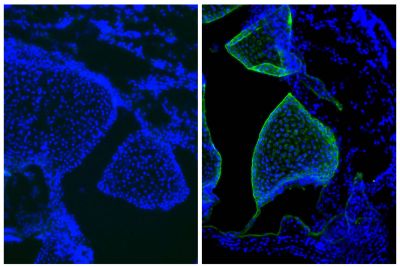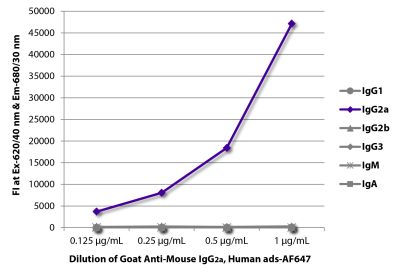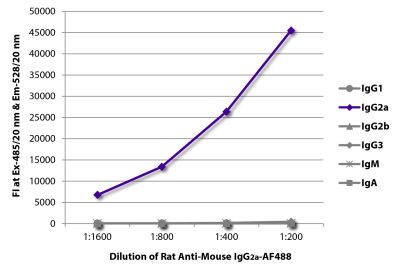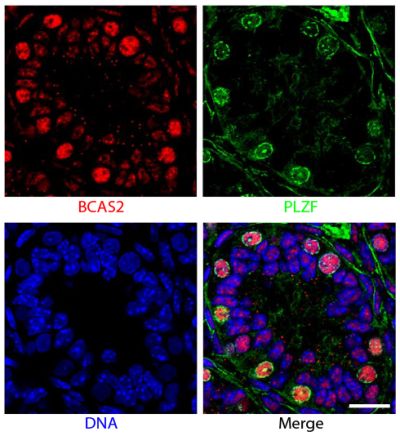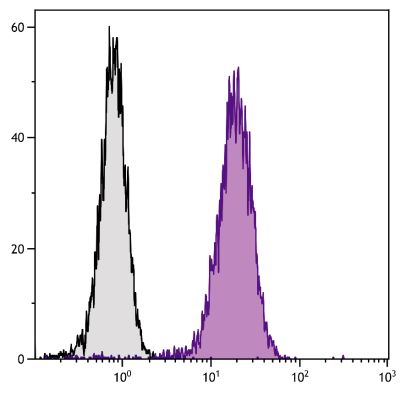Mouse Anti-Human CD107a-UNLB (H4A3)
Cat. No.:
9835-01
Purified Anti-Human CD107a antibody for use in flow cytometry, immunohistochemistry / immunocytochemistry, electron microscopy, western blot, immunoprecipitation, and purification assays.
$109.00




| Clone | H4A3 |
|---|---|
| Isotype | Mouse (BALB/c) IgG1κ |
| Isotype Control | Mouse IgG1-UNLB (15H6) |
| Specificity | Human/Rhesus/African Green Monkey/Pigtail Macaque/Sooty Mangabey CD107a |
| Alternative Names | LAMP-1, lysosome-associated membrane protein 1 |
| Description | CD107a, also known as lysosomal-associated membrane protein 1 (LAMP-1), is a heavily glycosylated type I transmembrane protein that constitutes the major sialoglycoproteins on lysosomal membranes. It is a ligand for galaptin, an S-type lectin present in extracellular matrix, through its recognition of acetyllactosamine oligosaccharide chains, and is a ligand for E-selectin-mediated cell adhesion. CD107a is expressed by activated T cells, macrophages, dendritic cells, activated platelets, tonsillar epithelium, and some tumor cell lines, including U937 and KG1a. It is also a widely expressed intracellular antigen. LAMP-1 may function in protecting the inner surface of the lysosomal membrane by forming a barrier to lysosomal hydrolases. The upregulation of both CD107a and CD107b on the surface of tumor cell lines has been associated with their enhanced metastatic potential where they may increase adhesion to extracellular matrix and endothelium. |
| Immunogen | Human adherent peripheral blood cells |
| Conjugate | UNLB (Unconjugated) |
| Buffer Formulation | Borate buffered saline, pH 8.2 |
| Clonality | Monoclonal |
| Concentration | 0.1 mg/mL |
| Volume | 1.0 mL |
| Recommended Storage | 2-8°C |
| Applications |
Flow Cytometry – Quality tested 1,12-19,21,22 Immunohistochemistry-Frozen Sections – Reported in literature 2 Immunohistochemistry-Paraffin Sections – Reported in literature 3,4 Immunocytochemistry – Reported in literature 5-10,20 Electron Microscopy – Reported in literature 1 Immunoprecipitation – Reported in literature 1,5,6 Western Blot – Reported in literature 11 Purification – Reported in literature 1 |
| RRID Number | AB_2797102 |
| Gene ID |
3916 (Human) 697331 (Rhesus) 103214841 (Green Monkey) 105485253 (Pigtail Macaque) 105584952 (Sooty Mangabey) |
| Gene ID Symbol |
LAMP1 (Human) LAMP1 (Rhesus) LAMP1 (Green Monkey) LAMP1 (Pigtail Macaque) LAMP1 (Sooty Mangabey) |
| Gene ID Aliases | CD107a; LAMPA; LGP120 |
| UniProt ID |
P11279 (Human |
| UniProt Name |
LAMP1_HUMAN (Human) |
Documentation
Certificate of Analysis Lookup
Enter the Catalog Number and Lot Number for the Certificate of Analysis you wish to view
- 1. Mane SM, Marzella L, Bainton DF, Holt VK, Cha Y, Hildreth JE, et al. Purification and characterization of human lysosomal membrane glycoproteins. Arch Biochem Biophys. 1989;268:360-78. (Immunogen, FC, EM, IP, Purification)
- 2. Momma K, Noguchi S, Malicdan MC, Hayashi YK, Minami N, Kamakura K, et al. Rimmed vacuoles in Becker muscular dystrophy have similar features with inclusion myopathies. PLoS One. 2012;7:e52002. (IHC-FS)
- 3. Furuta K, Ikeda M, Nakayama Y, Nakamura K, Tanaka M, Hamasaki N, et al. Expression of lysosome-associated membrane proteins in human colorectal neoplasms and inflammatory diseases. Am J Pathol. 2001;159:449-55. (IHC-PS)
- 4. Sarafian VS, Dikov DI. LAMPs and ABH histo-blood group antigens in granulation tissue. APMIS. 2007;115:701-6. (IHC-PS)
- 5. Hauck CR, Meyer TF. The lysosomal/phagosomal membrane protein h-lamp-1 is a target of the IgA1 protease of Neisseria gonorrhoeae. FEBS Lett. 1997;405:86-90. (ICC, IP)
- 6. Dell'Angelica EC, Aguilar RC, Wolins N, Hazelwood S, Gahl WA, Bonifacino JS. Molecular characterization of the protein encoded by the Hermansky-Pudlak syndrome type 1 gene. J Biol Chem. 2000;275:1300-6. (ICC, IP)
- 7. Valés-Gómez M, Winterhalter A, Roda-Navarro P, Zimmermann A, Boyle L, Hengel H, et al. The human cytomegalovirus glycoprotein UL16 traffics through the plasma membrane and the nuclear envelope. Cell Microbiol. 2006;8:581-90. (ICC)
- 8. Valés-Gómez M, Reyburn HT. Intracellular trafficking of the HCMV immunoevasin UL16 depends on elements present in both its cytoplasmic and transmembrane domains. J Mol Biol. 2006;363:908-17. (ICC)
- 9. Hanna MC, Blackstone C. Interaction of the SPG21 protein ACP33/maspardin with the aldehyde dehydrogenase ALDH16A1. Neurogenetics. 2009;10:217-28. (ICC)
- 10. Al-Zeer MA, Al-Younes HM, Lauster D, Lubad MA, Meyer TF. Autophagy restricts Chlamydia trachomatis growth in human macrophages via IFNG-inducible guanylate binding proteins. Autophagy. 2013;9:50-62. (ICC)
- 11. Armstrong A, Mattsson N, Appelqvist H, Janefjord C, Sandin L, Agholme L, et al. Lysosomal network proteins as potential novel CSF biomarkers for Alzheimer's disease. Neuromolecular Med. 2014;16:150-60. (WB)
- 12. Hershkovitz O, Rosental B, Rosenberg LA, Navarro-Sanchez ME, Jivov S, Zilka A, et al. NKp44 receptor mediates interaction of the envelope glycoproteins from the West Nile and dengue viruses with NK cells. J Immunol. 2009;183:2610-21. (FC)
- 13. Kozako T, Yoshimitsu M, Fujiwara H, Masamoto I, Horai S, White Y, et al. PD-1/PD-L1 expression in human T-cell leukemia virus type 1 carriers and adult T-cell leukemia/lymphoma patients. Leukemia. 2009;23:375-82. (FC)
- 14. Kozako T, Yoshimitsu M, Akimoto M, White Y, Matsushita K, Soeda S, et al. Programmed death-1 (PD-1)/PD-1 ligand pathway-mediated immune responses against human T-lymphotropic virus type 1 (HTLV-1) in HTLV-1-associated myelopathy/tropical spastic paraparesis and carriers with autoimmune disorders. Hum Immunol. 2011;72:1001-6. (FC)
- 15. Rosental B, Brusilovsky M, Hadad U, Oz D, Appel MY, Afergan F, et al. Proliferating cell nuclear antigen is a novel inhibitory ligand for the natural cytotoxicity receptor NKp44. J Immunol. 2011;187:5693-702. (FC)
- 16. Jaron-Mendelson M, Yossef R, Appel MY, Zilka A, Hadad U, Afergan F, et al. Dimerization of NKp46 receptor is essential for NKp46-mediated lysis: characterization of the dimerization site by epitope mapping. J Immunol. 2012;188:6165-74. (FC)
- 17. Genescà M, Skinner PJ, Bost KM, Lu D, Wang Y, Rourke TL, et al. Protective attenuated lentivirus immunization induces SIV-specific T cells in the genital tract of rhesus monkeys. Mucosal Immunol. 2008;1:219-28. (FC, Rhesus Reactivity)
- 18. Magalhaes I, Vudattu NK, Ahmed RK, Kühlmann-Berenzon S, Ngo Y, Sizemore DR, et al. High content cellular immune profiling reveals differences between rhesus monkeys and men. Immunology. 2010;131:128-40. (FC, Rhesus Reactivity)
- 19. Cicin-Sain L, Sylwester AW, Hagen SI, Siess DC, Currier N, Legasse AW, et al. Cytomegalovirus-specific T cell immunity is maintained in immunosenescent rhesus macaques. J Immunol. 2011;187:1722-32. (FC, Rhesus Reactivity)
- 20. Sauer J, Shannon JG, Howe D, Hayes SF, Swanson MS, Heinzen RA. Specificity of Legionella pneumophila and Coxiella burnetii vacuoles and versatility of Legionella pneumophila revealed by coinfection. Infect Immun. 2005;73:4494-504. (ICC, African Green Monkey Reactivity)
- 21. Jegaskanda S, Amarasena TH, Laurie KL, Tan H, Butler J, Parsons MS, et al. Standard trivalent influenza virus protein vaccination does not prime antibody-dependent cellular cytotoxicity in macaques. J Virol. 2013;87:13706-18. (FC, Pigtail Macaque Reactivity)
- 22. Dunham R, Pagliardini P, Gordon S, Sumpter B, Engram J, Moanna A, et al. The AIDS resistance of naturally SIV-infected sooty mangabeys is independent of cellular immunity to the virus. Blood. 2006;108:209-17. (FC, Sooty Mangabey Reactivity)
See All References


